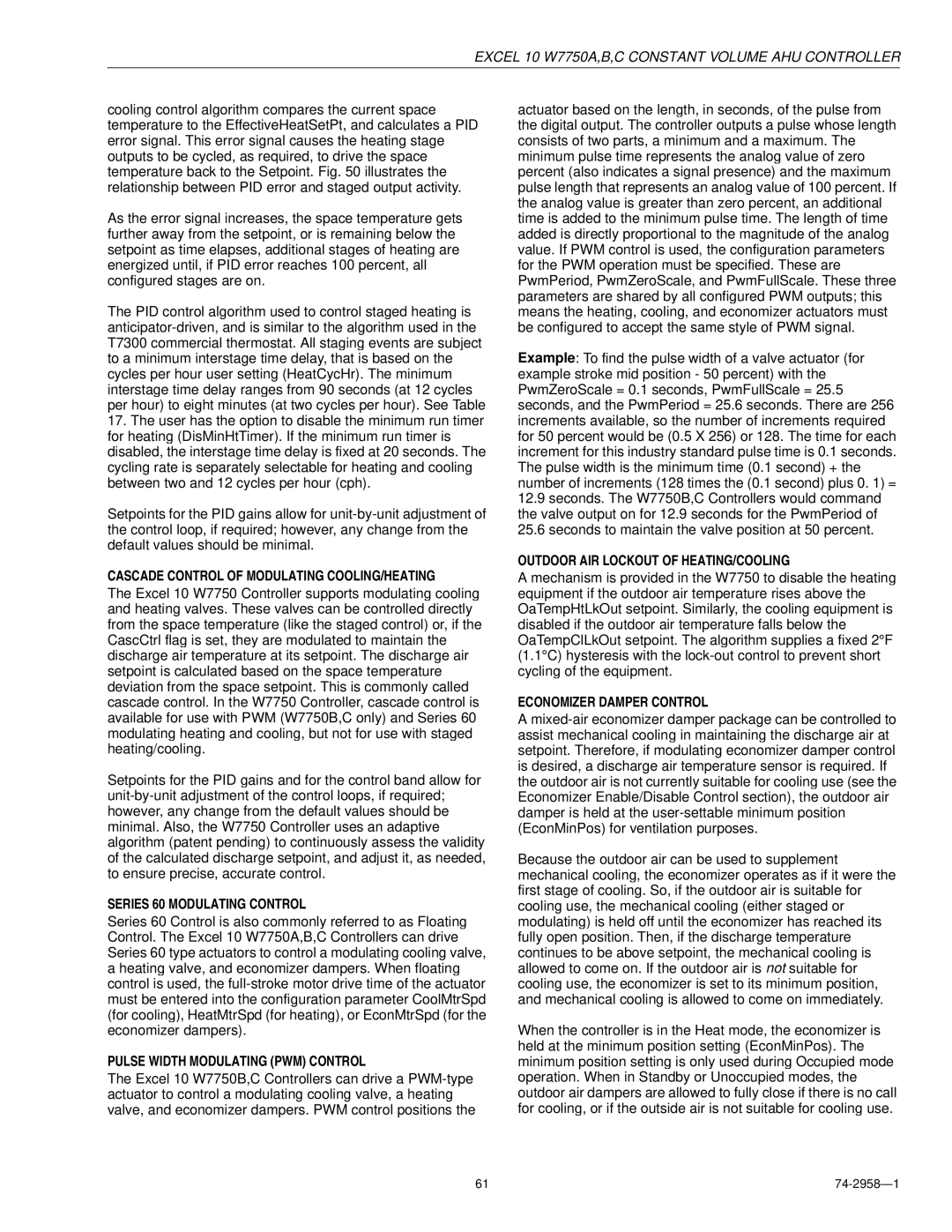EXCEL 10 W7750A,B,C CONSTANT VOLUME AHU CONTROLLER
cooling control algorithm compares the current space temperature to the EffectiveHeatSetPt, and calculates a PID error signal. This error signal causes the heating stage outputs to be cycled, as required, to drive the space temperature back to the Setpoint. Fig. 50 illustrates the relationship between PID error and staged output activity.
As the error signal increases, the space temperature gets further away from the setpoint, or is remaining below the setpoint as time elapses, additional stages of heating are energized until, if PID error reaches 100 percent, all configured stages are on.
The PID control algorithm used to control staged heating is
17.The user has the option to disable the minimum run timer for heating (DisMinHtTimer). If the minimum run timer is disabled, the interstage time delay is fixed at 20 seconds. The cycling rate is separately selectable for heating and cooling between two and 12 cycles per hour (cph).
Setpoints for the PID gains allow for
CASCADE CONTROL OF MODULATING COOLING/HEATING
The Excel 10 W7750 Controller supports modulating cooling and heating valves. These valves can be controlled directly from the space temperature (like the staged control) or, if the CascCtrl flag is set, they are modulated to maintain the discharge air temperature at its setpoint. The discharge air setpoint is calculated based on the space temperature deviation from the space setpoint. This is commonly called cascade control. In the W7750 Controller, cascade control is available for use with PWM (W7750B,C only) and Series 60 modulating heating and cooling, but not for use with staged heating/cooling.
Setpoints for the PID gains and for the control band allow for
SERIES 60 MODULATING CONTROL
Series 60 Control is also commonly referred to as Floating Control. The Excel 10 W7750A,B,C Controllers can drive Series 60 type actuators to control a modulating cooling valve, a heating valve, and economizer dampers. When floating control is used, the
PULSE WIDTH MODULATING (PWM) CONTROL
The Excel 10 W7750B,C Controllers can drive a
actuator based on the length, in seconds, of the pulse from the digital output. The controller outputs a pulse whose length consists of two parts, a minimum and a maximum. The minimum pulse time represents the analog value of zero percent (also indicates a signal presence) and the maximum pulse length that represents an analog value of 100 percent. If the analog value is greater than zero percent, an additional time is added to the minimum pulse time. The length of time added is directly proportional to the magnitude of the analog value. If PWM control is used, the configuration parameters for the PWM operation must be specified. These are PwmPeriod, PwmZeroScale, and PwmFullScale. These three parameters are shared by all configured PWM outputs; this means the heating, cooling, and economizer actuators must be configured to accept the same style of PWM signal.
Example: To find the pulse width of a valve actuator (for example stroke mid position - 50 percent) with the PwmZeroScale = 0.1 seconds, PwmFullScale = 25.5 seconds, and the PwmPeriod = 25.6 seconds. There are 256 increments available, so the number of increments required for 50 percent would be (0.5 X 256) or 128. The time for each increment for this industry standard pulse time is 0.1 seconds. The pulse width is the minimum time (0.1 second) + the number of increments (128 times the (0.1 second) plus 0. 1) =
12.9seconds. The W7750B,C Controllers would command the valve output on for 12.9 seconds for the PwmPeriod of
25.6seconds to maintain the valve position at 50 percent.
OUTDOOR AIR LOCKOUT OF HEATING/COOLING
A mechanism is provided in the W7750 to disable the heating equipment if the outdoor air temperature rises above the OaTempHtLkOut setpoint. Similarly, the cooling equipment is disabled if the outdoor air temperature falls below the OaTempClLkOut setpoint. The algorithm supplies a fixed 2° F (1.1° C) hysteresis with the
ECONOMIZER DAMPER CONTROL
A
Because the outdoor air can be used to supplement mechanical cooling, the economizer operates as if it were the first stage of cooling. So, if the outdoor air is suitable for cooling use, the mechanical cooling (either staged or modulating) is held off until the economizer has reached its fully open position. Then, if the discharge temperature continues to be above setpoint, the mechanical cooling is allowed to come on. If the outdoor air is not suitable for cooling use, the economizer is set to its minimum position, and mechanical cooling is allowed to come on immediately.
When the controller is in the Heat mode, the economizer is held at the minimum position setting (EconMinPos). The minimum position setting is only used during Occupied mode operation. When in Standby or Unoccupied modes, the outdoor air dampers are allowed to fully close if there is no call for cooling, or if the outside air is not suitable for cooling use.
61 |
|
